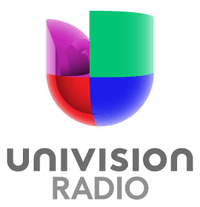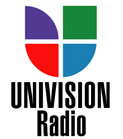Univision Radio
 | |
| Type | Radio network |
|---|---|
| Country | United States |
| Availability | National, through regional affiliates |
| Owner | Univision Communications |
Official website | Univision Communications Website |
Univision Radio is the radio division of media giant Univision Communications, Inc., which also owns the Univision television network. The company was formerly known as Hispanic Broadcasting Corporation. It is the eighth largest radio company in the United States, and the largest Hispanic radio company in the nation.
History
Univision, previously known as Hispanic Broadcasting Corp. (between 2000 and September 22, 2003) and Heftel Broadcasting Corp, was the result of a February 14, 1997 merger of Tichenor Media System, Inc. a private company based in Dallas, Texas and Heftel Broadcasting, a public company based in Las Vegas, Nevada.
Tichenor had been in broadcasting since the 1940s. McHenry Tichenor operated a station (KGBS on 1240, later KGBT on 1530) in Harlingen, Texas. In 1950, they added KUNO Corpus Christi, Texas. Later station purchases were KIFN in Phoenix, Arizona; WGMA in Hollywood, Florida; & WACO-AM-FM and TV (construction permit) in Waco, Texas. In 1975, the company (then known as Harbenito radio) added KCOR (AM) and KQXT (FM) in San Antonio.
In 1981, the grandson of the founder, McHenry T. Tichenor, Jr., was named president of the company. He began focusing on its Spanish Language stations; Waco, Hollywood, and Phoenix were sold to their local managers. In 1986 Tichenor bought WOJO, a Spanish-language FM station serving Chicago. In 1984, the company sold KQXT in San Antonio to Westinghouse's Group W Broadcasting and purchased KLAT (AM) in Houston, Texas from Marcos Rodriguez, Sr. and Marcos A. Rodriguez. The KLAT purchase gave Tichenor access to top Spanish Radio talents Chuck Brooks, Ricardo del Castillo (who later became COO, retired and has since passed) and Gary Stone (former President of Univision Radio-retired). In 1985, WIND, Chicago and KYSR AM-FM El Paso were purchased. More stations were purchased in the following years, and the home office moved from Harlingen to Dallas, Texas. Mac Tichenor, Jr.'s brother, Warren, (now Ambassador for the US to the United Nations) [1] became general manager of the San Antonio stations in 1991.

Heftel Broadcasting was founded by Cecil Heftel, whose family and in-laws all had been in the broadcasting business. His Heftel Broadcasting in the 1950s and early 1960s was anchored by KIMN in Denver and KGMB AM and KGMB-TV in Honolulu. He added numerous large AM radio stations (KTNQ) and some promising FM stations (KLVE) before selling them in the seventies and eighties. Cecil Heftel was elected as a congressman representing Hawaii's first district in 1976; he would hold that office nine years before resigning in 1986. During this time, his company was active, buying and selling stations in places like Indianapolis and Chicago. For about a year, Heftel and Scott Ginsburg (Statewide Communications)[2] merged their holdings into H & G Communications.
In the early 90s, Heftel began to expand into more Spanish stations, and took steps to go public (new executive Carl Parmer). Heftel had a knack for making coalitions work, at least for a time, as in the H & G attempt. Heftel set up shop in Miami with local stations WAQI and WRTO, taking a minority interest. Heftel set up Rodriguez-Heftel Texas broadcasting along with Marcos A. Rodriguez (owner of KESS and other Dallas area stations and son of Marcos Rodriguez, Sr.). Stations were purchased outright in Chicago, Las Vegas, and New York.
When HBC went public, Clear Channel Communications invested, taking in several steps up to a 20% interest. In 1996 Clear Channel tendered the shares owned by Heftel management. This got them about 62% of the company. They struck a deal to merge the new company with Tichenor Media, to be run by the Tichenor management. The deal closed in early 1997, and made for the first national Spanish Language broadcasting company.
The new company was worth 1 billion dollars at closing and owned 38 stations. Holding were expanded for the next several years. San Francisco was added in 1996. Phoenix was added in 1999. Fresno in 2000.
Besides buying stations, the company has developed a capacity for improving and expanding stations to enhance coverage. VP of Engineering Mark Stennett oversees this effort (begun under previous VP David Stewart now with Moving Target Consulting Works) along with Charles Staples of Staples Technical Services, Dallas, Texas. For example, 104.9 KAMA-FM (was KPTY) in the Houston, Texas area moved from a smaller class A at Rosenberg, Texas to a larger class C3 licensed to Missouri City, Texas. Coverage went from a few hundred thousand to millions. Rating and value increased proportionally. (Note a construction permit for increase to class C2 was granted (BPH-20070914ACP) June 25, 2008. This will allow an increase from 2,700 watts to 8,700 watts. The station will also move from a downtown building roof to the company owned KLTN tower.
May 2013: KAMA-FM has increased power to 10.5 kW. Other expanded and relocated stations include KFLC, KESS-FM and KDXX (FM) in the Dallas-Ft. Worth area, KBBT and KGSX in the San Antonio area, KLQV San Diego, and WADO (AM) New York. KKMR in the Phoenix, Az. area was recently granted a CP to change from class A to class C3, at a new site that will allow a 10 fold increase in its population covered. This app was started nearly a decade ago and was granted based on tweaks in the application done in 2006.[3] Former CFO Jeff Hinson observed once that the station upgrade activity had increased the company's enterprise value by "almost one billion dollars" (at a point when the company was selling to UVN for 3.5B).
In 1999, the company created a new entity, HBCI, Inc which was its interactive online presence. HBCi created a network of bilingual radio station web sites and a network of bilingual local city guide sites focused on the local Hispanic consumer in each of the markets the radio stations operated. HBCI achieved the rare milestone of reaching profitability in the dotcom industry just prior to the merger with Univision.
The company traded on the NASDAQ exchange under the symbol HBCCA. It moved to the New York Stock Exchange in May 2000. Stock traded as HSP.
In mid-2002, Univision and HBC voted to merge. The approval process was long and controversial. The deal was approved and closed on September 22, 2003.[4]
After the merger of HBC and Univision, the division was renamed Univision Radio.
In June 2006, a deal to sell the company to a consortium of private equity firms was announced.
On March 27, 2007, federal regulators approved the sale of Univision to Broadcasting Media Partners, a private consortium led by billionaire Haim Saban.
Some of the syndicated shows in the Univision Radio network include: “El Bueno, La Mala y El Feo” (“The Good, The Bad and The Ugly”), “The Enrique Santos Morning Show”, “Doctora Isabel”, “El Show de Raúl Brindis”, "El Show de Omar y Argelia”, “El Hit Parade de América con Javier Romero”, and “Intimo con Alberto Sardiñas”.
References
- ↑ Warren Tichenor Biography-US Department of State
- ↑ Jordan Ginsburg-Statewide co-owner, passes away August 26, 2009, Boca Ration, FL
- ↑ KMMR License Application information-Federal Communications Commission
- ↑ JAMES, MEG (2002-06-12). "Univision to Acquire Hispanic Broadcasting". Los Angeles Times. ISSN 0458-3035. Retrieved 2015-10-25.